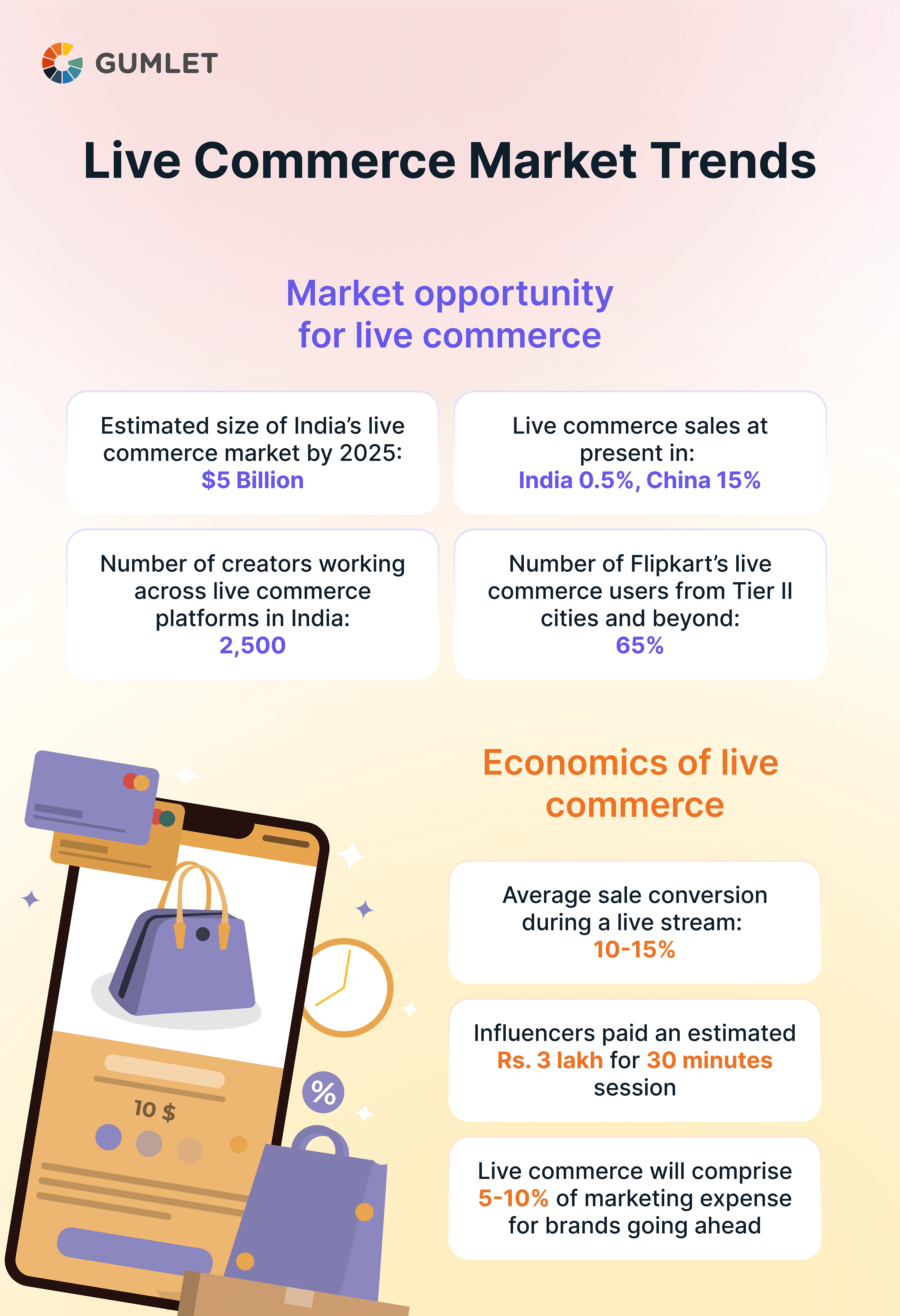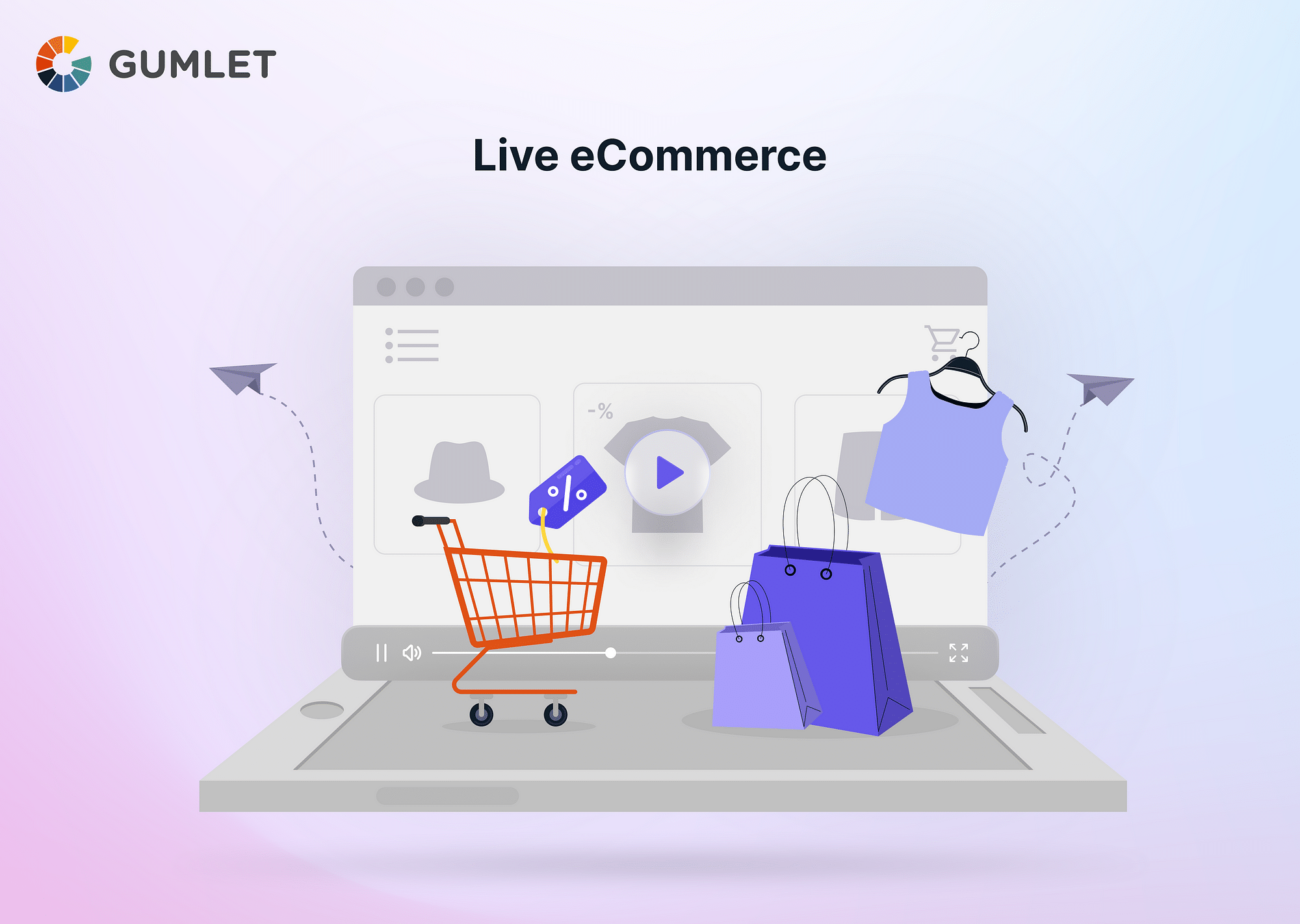In today's digital era, the retail industry continuously evolves to meet consumer needs and expectations. From brick-and-mortar stores to e-commerce and the emergence of live commerce now, the way we shop is transforming significantly. Live commerce, the latest trend in the online shopping world, offers an innovative, interactive, and immersive shopping experience that reshapes retail dynamics.
What is Live Commerce?
Live commerce is the fusion of live streaming and online shopping, which enables real-time interaction between sellers and buyers. It provides an immersive experience where consumers can ask questions, get immediate responses, and see live demonstrations of products.
History of Live Commerce
- Live commerce, originating in China, has gained popularity due to its cultural, economic, and technological elements. It was introduced in the mid-2010s, combining strong internet connectivity, high mobile penetration rates, and existing e-commerce environments with digital payment and online retail systems. Asia's love for influencer culture also facilitated the integration of live streaming, allowing influencers to influence their audience's buying decisions directly.
- The West, particularly the U.S. and U.K., adopted live commerce more cautiously due to cultural differences, privacy values, and the influence of influencer marketing. Western consumers may find direct interaction intrusive, and the entrenched nature of traditional e-commerce may make them resistant to switching to new methods.
- Yet, the tides are shifting. Western countries have begun recognizing live commerce's merits. The uptake might be more gradual compared to Asia, but there's undeniable growth. Platforms such as Amazon Live and YouTube Live Shopping are a testament to live commerce's burgeoning popularity in the West, reshaping the narrative and future of global shopping trends.
Live Commerce vs. Traditional E-Commerce
Live commerce revolutionizes online shopping by enhancing consumer and brand interactions through real-time engagement. Despite its unique benefits, it offers a compelling, novel approach to digital retail.
- Real-time Engagement: Live commerce transforms the solitary act of online shopping into a social, interactive experience. Customers can watch live demonstrations, ask questions, and get immediate responses. This live interaction starkly contrasts traditional e-commerce, where customer communication typically occurs via email or chatbots.
- Enhanced Trust and Transparency: One of the significant concerns with traditional e-commerce is the skepticism around product quality. Live commerce addresses this by showcasing products in action, allowing customers to see exactly what they're purchasing. This real-time transparency fosters trust, a critical factor influencing online purchase decisions.
- Cultivating Community: In traditional e-commerce, transactions are often one-dimensional and lack a sense of community. Live commerce, on the other hand, promotes a communal experience. Customers can interact not only with the host but also with other shoppers, fostering a vibrant community that enhances the shopping experience.
- The Power of Immediacy: The instantaneous nature of live commerce sparks urgency among viewers, often leading to impulsive purchases. With real-time exclusive deals and limited-time offers such as Halloween or Black Friday deals, live commerce taps into consumers' fear of missing out, a psychological factor absent in traditional e-commerce.
- Leveraging Influencer Impact: Unlike traditional e-commerce, live commerce prominently features influencers as hosts. These influencers leverage their follower base, reputation, and charisma to drive sales, making live commerce an influential marketing platform.
How Brands are Leveraging Live Commerce?
In the current digital landscape, brands always look for innovative ways to engage customers and boost sales. Live commerce offers a unique platform that merges entertainment with shopping, making it an appealing marketing tool for businesses. Brands are exploiting this new medium in various ways, including interactive product demonstrations, offering limited-time deals, fostering real-time customer interactions, and capitalizing on influencer collaborations.

Interactive Product Demonstrations
Live commerce provides a platform for brands to demonstrate their products in real-time. For instance, tech giant Apple has effectively used live streaming for their product launches, enabling them to interactively showcase product features and capabilities. Similarly, beauty brands like Sephora frequently use live commerce for makeup tutorials, showcasing their range of products while also educating viewers about application techniques.
Limited-time Offers and Exclusive Deals
Brands often use the "fear of missing out" (FOMO) phenomenon to their advantage in live commerce. For example, fashion retailer Zara has been known to offer exclusive deals during their live streams, driving urgency among viewers and encouraging immediate purchases.
Real-time Customer Interaction
Live commerce allows brands to interact with their customers directly. During Amazon Live streams, for instance, viewers can ask questions about the products being showcased. Amazon representatives or product experts answer them in real-time, providing immediate customer service and enhancing customer engagement.
Influencer Collaborations
Brands have quickly understood the impact influencers can have on live commerce. Gymshark, a fitness apparel brand, often collaborates with fitness influencers who use live streams to conduct workouts while simultaneously showcasing Gymshark's products. This form of collaboration promotes the products and helps the brand connect with the influencer's substantial following.
Top Live Commerce Platforms
As live commerce grows in popularity, several platforms emerge as leaders in the space. These platforms are pioneering the trend by offering unique features that enhance the live shopping experience, making it interactive, engaging, and seamless. Let's delve into some of the top live commerce platforms currently dominating the market and understand what makes them stand out.
Amazon Live
Amazon Live is a unique fusion of live streaming and shopping within the vast ecosystem of the Amazon marketplace. One noteworthy feature is the "Live Chat," allowing viewers to interact directly with brands and influencers. Furthermore, the platform uniquely integrates Amazon's extensive product catalog, allowing consumers to seamlessly add products featured in the live stream to their cart, enhancing the shopping experience.
Alibaba
Alibaba is a key player in the live commerce space, particularly in Asia. Its platform, Taobao Live, has been a trendsetter in live commerce since its inception. Taobao Live has been home to some of the most memorable live commerce events, including a live stream by Viya, a famous Chinese influencer who once sold a rocket launch service for $5.6 million. This platform's success lies in its ability to weave storytelling, entertainment, and shopping into a single seamless experience.
TikTok Live Shopping
TikTok, a platform initially popular for short-form videos, has evolved into a major player in live commerce with its "Live Shopping" feature. In collaboration with brands and influencers, TikTok enables product showcasing and purchasing directly through the app. One unique aspect of TikTok is its algorithm, which excels at introducing consumers to new influencers and products based on their viewing habits, making each user's live shopping experience tailored and personalized.
YouTube Live Shopping
YouTube has long been a go-to platform for product reviews and demonstrations. With the introduction of YouTube Live Shopping, the platform has expanded to include real-time purchasing capabilities. Brands and influencers can host shopping events where viewers can watch, interact, and buy products without leaving the platform. Integrating shopping features with YouTube's extensive video content is a unique blend, offering an unparalleled live commerce experience. This could be a great YouTube marketing strategy to expand your brand reach.
Future of Live Commerce: The Road Ahead

Live commerce promises an evolved digital shopping experience by merging the immediacy of in-store shopping with online convenience, highlighted by live demos and real-time interactions.
- Brands can utilize live commerce for enhanced video storytelling, deepening customer connections through influencer partnerships and interactive content, and fostering engagement and loyalty.
- The fusion of AI and AR with live commerce is on the horizon, paving the way for innovative features such as virtual try-ons and smart product suggestions, elevating interactivity and customization.
Navigating Challenges in Live Commerce
Despite its promising prospects, live commerce is not without its challenges. Here are a few hurdles that brands may encounter while venturing into this new mode of e-commerce:
- Maintaining Engagement: With the influx of live streams, it can be a challenge for brands to deliver unique and engaging content to retain viewer interest consistently. Furthermore, conducting live streams requires considerable time and resources, which might be challenging for smaller businesses.
- Tech Infrastructure: The seamless operation of live commerce requires robust technical infrastructure. Any lags or glitches during the live stream can negatively impact the customer experience, potentially resulting in lost sales.
- Privacy Concerns: Since live commerce encourages direct interaction, privacy and data security concerns can arise. Brands must ensure they adhere to data protection regulations and respect customer privacy.
- Return and Refund Policies: Given the impulsiveness encouraged by live commerce, customers may make hasty purchase decisions, potentially leading to higher returns. Brands must have clear and customer-friendly return policies in place to handle such situations.
- Dependency on Influencers: As live commerce heavily relies on influencers, there's a risk of over-dependency. Any negative actions or statements by the influencers can impact the brand's reputation and sales.
Despite these challenges, the potential of live commerce is undeniable. With careful planning and strategic execution, brands can effectively navigate these hurdles and harness the power of this innovative platform.
Conclusion
Live commerce represents a vibrant future for online shopping, merging the convenience of e-commerce with the immediacy and interactivity of live video. While still a relatively new concept in some regions, it has massive potential to revolutionize retail experiences globally.
FAQs:
1. How can small businesses leverage live commerce?
Small businesses can use live commerce to demonstrate products, offer limited-time deals, and interact with customers in real-time. It also allows collaboration with influencers who can boost their reach and visibility.
2. What is the difference between social commerce and live commerce?
While both concepts involve social interaction and online shopping, social commerce typically refers to purchasing products directly through social media platforms. On the other hand, live commerce specifically involves the use of live streaming to showcase products and interact with consumers.
3. How can businesses measure the success of live commerce campaigns?
Businesses can use various metrics such as viewer count, engagement rate (likes, comments, shares), conversion rate (how many viewers make a purchase), and average order value.
4. What are the categories of live commerce?
Live commerce spans various categories, including fashion, beauty, electronics, home goods, etc. Any product that can benefit from live demonstration and real-time interaction potentially fits the live commerce model.




